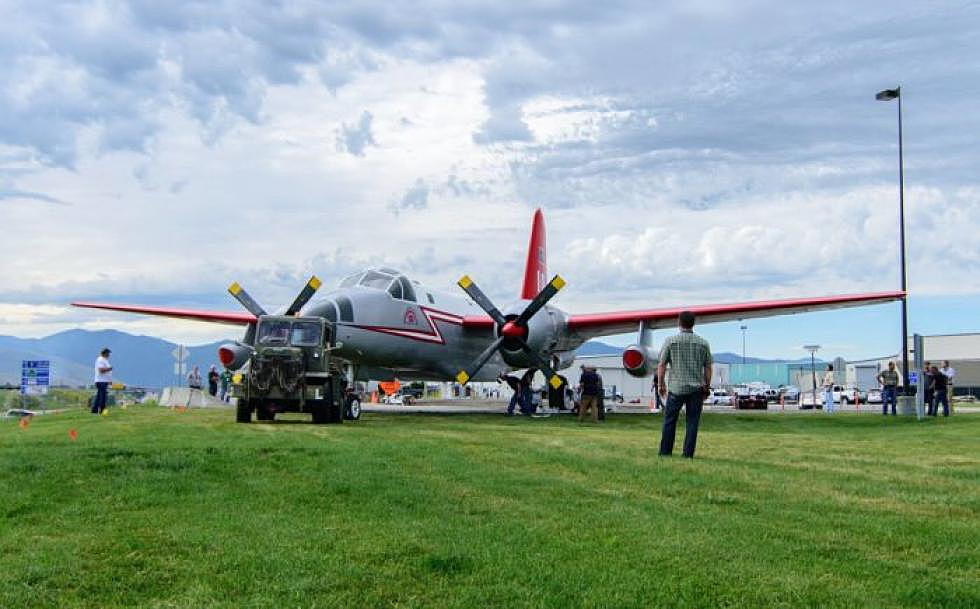
Tanker 10 begins new mission at Missoula International Airport
Tanker 10 has a new base of operations, standing sentinel at the entrance to Missoula International Airport, forever reminding local citizens and visitors of the city’s pre-eminent role in the history of wildland firefighting.
The slurry bomber’s move Tuesday from Neptune Aviation’s hangar to a static display area alongside Highway 10 West was a logistical challenge, but a welcome one for the aerial firefighting company’s crews.
“As we celebrate the end of the P2V’s mission as an aerial firefighting aircraft, having Tanker 10 displayed in Missoula is an honor,” said Ron Hooper, CEO of Neptune Aviation, whose pilots flew the slurry bomber for 24 years.
The one-mile journey required a carefully timed tow across the runway, the removal of several fences and a veritable tip-toe over the curb and across a side street, but the storied aircraft arrived unscathed.
In fact, Neptune refurbished Tanker 10 over the past year in preparation for its new mission as the airport’s gate guard, removing all reusable avionics, applying new paint and installing solar-powered nighttime running lights.
Missoula airport officials have long wanted a grander “welcome” icon at the entrance, and seized the opportunity when Neptune retired Tanker 10 at the end of last fire season.
“Missoula has been home to P2V firefighting air tankers for more than 50 years, first with Johnson Flying Service and more recently with Neptune Aviation,” said Cris Jensen, the airport’s director. “Having a P2V air tanker greet visitors as they arrive at the airport is a fitting tribute to the history of Missoula’s role in aerial firefighting.”
In its two decades on fire duty, Tanker 10 dropped more than 11 million gallons of fire-slowing retardant, according to Neptune.
Lockheed built the aircraft in 1957 for the U.S. Navy, which put it to work for 25 years as a submarine chaser and reconnaissance aircraft. One Navy photograph shows Tanker 10 patrolling the waters off the Florida coast during the Cuban Missile Crisis.
The P2V was the longest-produced aircraft in Navy history, rolling off the assembly line from 1954 to 1957. When on submarine watch, the aircraft flew low over the ocean for 10 and 11 hours at a time while its crew hunted enemy subs.
Black Hills Aviation and then Missoula-based Neptune Aviation retrofitted the airplanes for use as retardant planes, trading its submarine detection gear for six compartments that held the thick, syrupy mixture used to impede a wildfire’s advance.
At retirement, Tanker 10 had flown 11,000 engine hours. (That’s five roundtrips to the moon, by Neptune’s calculations.)
Its pilots believed the P2V to be perfectly designed for firefighting. It was strong and had lots of power. The pilot and co-pilot had good visibility from the flight deck. It had an honest wing that wanted to fly.
But 2017 is the last year the U.S. Forest Service will use P2Vs for firefighting, so Neptune Aviation has transitioned from the older submarine chasers to newer British Aerospace BAe-146 jets.
The company now has bases in Missoula and Alamogordo, New Mexico, and has a staff of more than 200. It has pioneered the retrofitting of the BAe-146 for firefighting and has aircraft on duty now year-round, and most recently in both North and South America.
It’s time to bid farewell to the aging P2Vs.
Said Hooper: “Neptune currently has six P2Vs in service. At the end of the 2017 fire season, we will keep two aircraft operational for airshows. The remaining aircraft will go to museums around the country.”
But Tanker 10 will forever stay close to home, a reminder to all of one proud aircraft’s history of service to country.
Sherry Devlin is a longtime Missoula journalist who writes occasional stories for Missoula Current.
